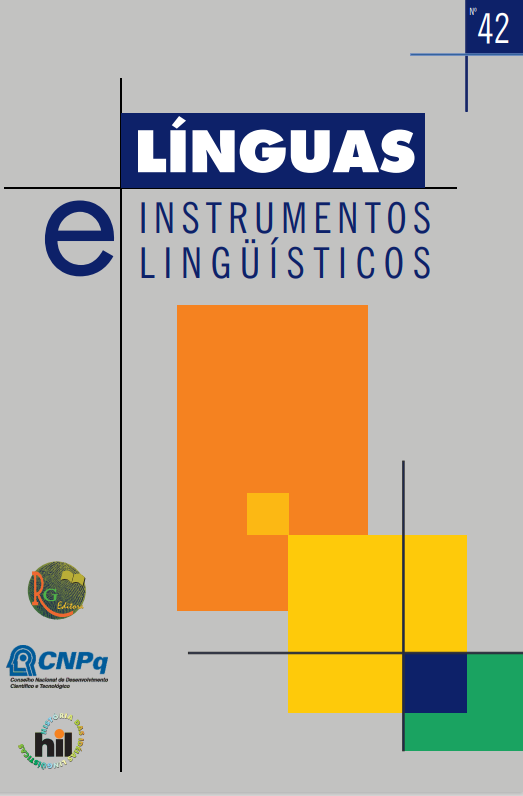Abstract
This article presents a detailed description of the distinct ways of indexing a third-person pronominal referent on Parkatêjê verbs. Parkatêjê is a Jê language belonging to the Timbira Dialectal Complex, and spoken in the Southeast part of the State of Pará (Brazil). The motivation to investigate this specific topic was that it had not been the focus of a thorough analysis in the previous studies on the language (FERREIRA, 2003; ARAÚJO 1989). Based on morphosyntactic, phonotactic and historical-comparative criteria, we describe the several forms of expressing the third person with verbs in Parkatêjê, and propose a revised list of Parkatêjê personal pronouns, which includes the forms for third-person singular and plural. In addition, we compare the pattern of verbal third person expression of Parkatêjê to the patterns found in other Northern Jê languages, such as Mẽbẽngokrê, Krahô, Pykobjê and Apãniekrá.
References
AMADO, R. (2004). Aspectos morfofonológicos do Pykobjê-Gavião. Tese (Doutorado em Semiótica e Linguística Geral) - Faculdade de Filosofia, Letras e Ciências Humanas, Universidade de São Paulo, São Paulo.
ARAÚJO, L. (1977). Estruturas Subjacentes de alguns tipos de frases declarativas afirmativas do dialeto gavião-jê. Dissertação (mestrado) Universidade Federal de Santa Catarina, Florianópolis. __________. (1987). Aspectos da Língua Gavião-Jê. Rio de Janeiro. Tese (doutorado) – Universidade Federal do Rio de Janeiro, Faculdade de Letras.
BHAT. D.N.S. (2004). Pronouns. Oxford University Press.
CASTRO ALVES, F. (2004). O timbira falado pelo Canela Apãniekrá: uma contribuição aos estudos da morfossintaxe de uma língua Jê. Tese de Doutorado. Campinas: Unicamp.
COMRIE, B. (1989). Language universals and linguistic typology: Syntax and morphology. 2nd ed. Chicago: University of Chicago Press. ____________. (2013). “Alignment of Case Marking of Full Noun Phrases”. In: Dryer, Matthew S. & Haspelmath, Martin (eds.) The World Atlas of Language Structures Online. Leipzig: Max Planck Institute for Evolutionary Anthropology. Available online at: http://wals.info/chapter/98. Accessed on: 2019-01-22.
DIXON, R. M. W. (1994). Ergativity. Cambridge: Cambridge University Press.
FERREIRA, M. (2003). Estudo morfossintático da língua Parkatêjê. Tese de Doutoramento. UNICAMP: Campinas.
HASPELMATH, M. (2013). “Argument indexing: A conceptual framework for the syntax of bound person forms”. In: Bakker, Dik & Haspelmath, Martin (Eds.) Languages across boundaries: Studies in memory of Anna Siewierska. Berlin: De Gruyter Mouton, p.197-226 __________________. (2014). “The challenge of making language description and comparison mutually beneficial’. In: Linguistic Typology, 20(2), p.299-301.
HOCK, H. (1991). Principles of historical linguistics. Second, corrected and augmented edition. Berlin: Mouton de Gruyter.
NEVES, C. L. (2012). Alternância de códigos em narrativas orais do povo Parkatêjê: aspectos linguísticos do contato com o português. Dissertação (Mestrado em Linguística) - Universidade Federal do Pará, Belém.
OLIVEIRA, C. O. (2003). "Lexical categories and descriptives in Apinajé”. IJAL, v.69, n.3, p.243-274. Chicago: The University of Chicago,
POPJES, J; POPJES, J. (1986). “Canela-Krahô”. In: DERBYSHIRE,
D. & PULLUM, G. (Eds.). Handbook of Amazonian Languages. Vol.l. Berlin: Mouton de Gruyter.
RIBEIRO-SILVA, N. (2016). Pronomes em Parkatêjê: a expressão da terceira pessoa. Dissertação de Mestrado. Belém: UFPA.
SALANOVA, A. P. (2011). “A flexão de terceira pessoa nas línguas Jê”. Revista Liames, v.11, p.75-114, Primavera.
SILVA, M. A. R. (2001). Pronouns, ordem e ergatividade em Mebengokre (Kayapó). Dissertação de mestrado. Campinas: IEL/UNICAMP.
SCHACHTER, P.; SHOPEN, T. (2007). “Parts-of-speech systems”.
In: SHOPEN, T. (ed). Language Typology and Syntactic Description. Vol.1, p.1-60, 2. ed. Cambridge: Cambridge University Press. ____________. (2007). Language typology and syntactic description. 3 volumes, 2. ed. Cambridge: Cambridge University Press.
SIEWIERSKA, A. (2013). “Alignment of Verbal Person Marking”.
In: DRYER, Matthew S. & HASPELMATH, Martin (Eds.). The World Atlas of Language Structures Online. Leipzig: Max Planck Institute for Evolutionary Anthropology. Available online at: http://wals.info/chapter/100. Accessed on: 2019-01-22.
SOUZA, S. M. de. (1989). O sistema de referência pessoal da língua Krahô. Dissertação (Mestrado em Semiótica e linguística geral) – Faculdade de Letras, Universidade Federal de Goiás, Goiás.

This work is licensed under a Creative Commons Attribution-NonCommercial-ShareAlike 4.0 International License.
Copyright (c) 2020 Línguas e Instrumentos Línguísticos


